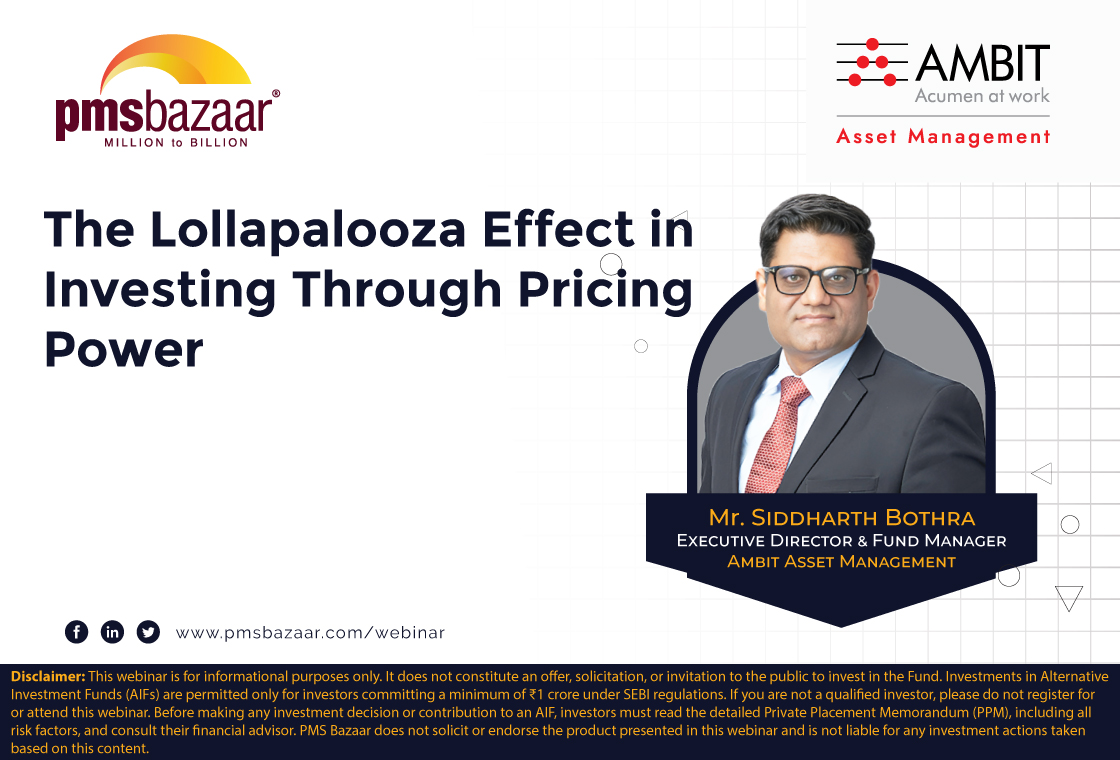PMS Bazaar's recent webinar, "Navigating Sector Rotation in Small & Midcaps Post Election," featured Arpit Shah, Co-Founder & Investment Director at Care Portfolio Managers. It discussed historical sector performance (2014-2019 vs. post-2019) and highlighted thriving sectors (consumer durables, banking) vs. lagging ones (metals, media).

Arpit Shah, in the webinar, emphasised government policies, economic reforms, and valuations impacting sectors, and how potential post-election policy shifts could affect defence, infrastructure, and agriculture. He stressed strategic stock selection.
Key aspects covered in this webinar blog are
- Historical Sector Performance: 2014-2019 vs. 2019-2024
- Factors driving sector rotation
- Sector Rotation Strategies
- Navigating Sector Disruptions
Historical Sector Performance: 2014-2019 vs. 2019-2024
In the first part of his webinar, Arpit Shah focused on historical performance. He compared the Nifty and sectoral indices over two distinct periods: 2014-2019 and 2019-2024. The first period saw strong performance from consumer durables and banking sectors, while metals and media underperformed. This trend reversed significantly post-2019, particularly with the COVID-19 pandemic. Metals and realty sectors saw a resurgence, while financial services like banking took a backseat.


Factors driving sector rotation
Shah then delved into the factors driving sector rotation. He identified three key drivers: economic reforms and policy changes, valuation and earnings growth, and government policies with specific sectoral impacts.
Firstly, Shah explained how economic reforms and policy changes can significantly influence sector rotations. He provided examples like reforms in banking and financial sectors, or the Uday scheme for the power sector, highlighting how such initiatives can dramatically impact performance within those sectors. He also mentioned that global factors like supply and demand dynamics and geopolitical events can affect specific sectors at different times. These policies can create tailwinds for certain industries and reshape the investment landscape. For instance, the cyclical nature of government spending, particularly in infrastructure and agriculture, significantly impacts how different sectors perform.
Secondly, Shah emphasised the profound influence of government policies on specific sectors. He pointed to examples like the implementation of the National Company Law Tribunal (NCLT), the recapitalisation of public sector banks, and the post-COVID-19 PLI schemes. These policies have demonstrably bolstered sectors like metals, infrastructure, and manufacturing.
Shah shifted his focus to the future outlook and the implications of policy changes. He specifically highlighted sectors like defence, infrastructure, and agriculture as being potentially impacted by these changes. Shah concluded by urging investors to stay informed about evolving government strategies, as these policy changes could redefine sectoral dynamics in the coming years.
Finally, Shah discussed the role of valuation and earnings growth. He explained that sectors experiencing improved earnings and subsequent re-rating tend to attract investor interest. Conversely, sectors with stagnant growth face challenges and may be less attractive.
Sector Rotation Strategies
Arpit Shah provided a detailed analysis of sector rotation dynamics, emphasising key triggers and tactical manoeuvres for optimising portfolio performance.
- Entry and exit
Sector rotation, as Shah articulated, revolves around strategic entries and exits based on valuation dynamics and market trends. He underscored the critical role of valuation in determining when to exit sectors, citing examples from infrastructure and FMCG sectors where high valuations signal caution unless earnings catch up.
Shah illustrated his points with compelling case studies from CARE PMS's strategy. He detailed how the firm successfully navigated sector shifts, such as exiting the IT sector due to global economic uncertainties and increasing exposure to textiles and stationery post-COVID-19. These moves were guided by a rigorous top-down approach, focusing on sectors poised for growth due to strategic shifts in global manufacturing and policy reforms.
- Sectoral shift by CARE PMS
Reflecting on recent sectoral moves, Shah elaborated on CARE PMS's strategy adjustments. Notable shifts included a significant increase in mining sector investments following government policy reforms aimed at enhancing self-sufficiency in rare earth minerals. These proactive adjustments enabled CARE PMS to capitalise on emerging opportunities and deliver substantial returns for investors.
- Portfolio Construction
Discussing portfolio construction principles, Shah emphasised a balanced approach with diversified holdings across 8 to 10 sectors, each capped at 20% exposure to mitigate risks. He highlighted current top holdings such as JK Paper and strategic cash reserves, underscoring the portfolio's resilience amidst market fluctuations and its attractive valuation relative to broader indices.
Navigating Sector Disruptions
Shah highlighted the ever-present threat of industry upheaval and the need for constant watchfulness. He used the traditional power generation sector as an example, where the rise of renewable energy, particularly solar power backed by government initiatives, is poised to reshape the landscape. This scenario underlines the potential for unforeseen disruptions to impact any industry.
- Fintech: A Case Study in Disruption
Shah drew a parallel between the impending energy sector shift and the already established disruption caused by fintech in traditional banking. The emergence of powerful players from the fintech arena demonstrates the unexpected nature of these industry-wide changes. Shah stressed that such disruptions necessitate ongoing monitoring and adjustments to investment strategies.
Gain a deeper understanding of the topics discussed by Arpit Shah. Watch the webinar recording, including the Q&A session, at the link below.
Get access to rich data and analytics of PMS & AIF by subscribing to us. Join the 65000+ investors & experts: Subscribe NOW
Recent Blogs

PMS performance hit by broad market slump in July; Thematic strategies buck the trend
Of 427 equity PMSes, only 61 gained; Debt offerings showed positive returns. July 2025 proved to be a testing month for Portfolio Management Services (PMS) investors, with broad-based declines across most asset classes.

July tests AIF resilience; Long-short strategies lead relative gains game
Only 44 of 137 AIFs ended positive; long-only funds averaged –1.15%, while long-short peers limited losses to –0.29%

The Lollapalooza Effect in Investing Through Pricing Power
PMS Bazaar recently organized a webinar titled “The Lollapalooza Effect in Investing Through Pricing Power” which featured Mr. Siddharth Bothra, Executive Director and Fund Manager, Ambit Asset Management. This blog covers the important points shared in this insightful webinar.

The Secret Sauce of Quant PMS
PMS Bazaar recently organized a webinar titled “The Secret Sauce of Quant PMS,” which featured Mr. Vivek Sharma, VP & Investment Head, Estee Advisors Private Limited.

Bridging Performing Credit and Emerging Equity for Balanced Wealth Creation
PMS Bazaar recently organized a webinar titled “Bridging Performing Credit and Emerging Equity for Balanced Wealth Creation,” which featured Mr. Phanisekhar Ponangi, Co-Founder and CIO, MavenArk Asset Managers Pvt Limited. This blog covers the important points shared in this insightful webinar.

Equity PMS performance steady in June; over 99% in green as rally broadens
Best schemes log 10-19% gains, but the overall extent of outperformance vs. benchmarks was lower compared to May

June Brings Steady Gains for AIFs; Long-Only Strategies Maintain Lead
126 of 129 AIFs ended in the green; long-only funds averaged 3.75%, while long-short peers delivered a modest 2.18%

Alpha from Simplicity: The Power of Vanilla Investing
PMS Bazaar recently organized a webinar titled “Alpha from Simplicity: The Power of Vanilla Investing,” which featured Mr. Sheetal Malpani, Chief Investment Officer and Head of Equity, Tamohara Investment Managers. This blog covers the important points shared in this insightful webinar.

